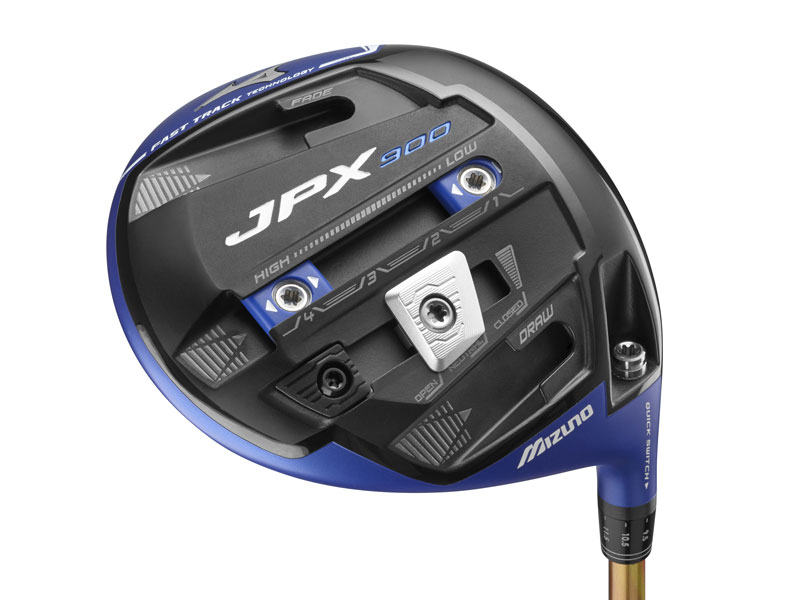Mizuno isn’t typically known as a driver company, but they continue to impress with each new iteration of their clubs–the JPX900 driver included. With every new release, Mizuno’s drivers just keep getting better and better.
I like the matte, husky hue of blue on the new Mizuno JPX850 driver. It’s a darker blue, which I prefer, and it’s not as glossy as the prior driver.
Even though the JPX900 has two 440cc heads, it appears larger at address. This is because Mizuno has shallowed and deepened the club’s face in order to increase forgiveness.
The JPX900 has a wider head, which gives it a more powerful sound. The sound is also higher pitched, because it echoes around the larger chamber. This is all good, because it makes the club more versatile.
The sole of the Fast Track JPX850 design remains the same, but with further heel and toe ports placed apart for draw and fade, as well as a longer central track.
Additionally, it now has four locations marked instead of three, but you may actually place the two 8g weights anywhere you choose, adding another level of freedom.
The head of the club is positioned at 9.5° in the neutral position. You can use the adjustable hosel to change the lie by 1° or 2°, depending on whether you are using a standard or upright lie. This feature is also backward compatible, meaning it can be used with earlier models of golf clubs or shafts.
If you change the loft on your club, you will also affect the face angle and lie. If you don’t like the way the new loft impacts the look of the face, If the silver face angle prop is not in the desired position, it can be used to realign it.
It certainly looks a bit agricultural, and I’m not sure how much it affects the aerodynamics. However, it does do the alignment job very well, allowing you to orientate the face wherever you want it.
I had my doubts about this method when I first heard of it in relation to the R1 drivers and TaylorMade R11. However, after trying it myself, I can confirm that it does work – as long as you take your grip on the driver after grounding it.
The Mizuno version of the club is a better choice purely for visual reasons. By changing the loft, you will change the angles and weight balance of the club, neither of which can be changed easily.
The head of the club is much larger than average, which makes it easier to hit the ball. It has a 440cc volume, which is impressive for such a large head.
The JPX900 comes with an eye-catching orange Fujikura Evolution II shaft that
perfectly complements the blue head. This high-quality shaft is a significant upgrade from the standard Mizuno shaft, and is sure to improve your game.
There’s no denying that I have a bit of a soft spot for this model of golf shaft. I know from experience that it suits my swing, and initial testing showed that it could produce some very accurate drives. Rather than messing around with the heel and toe weight positions, I decided to put both weights in the central Fast Track position for maximum power.
As a result of my previous evaluation of the JPX850 driver, I was aware that my ideal setup was 10.5° with both weights evenly distributed. I therefore configured the JPX900 identically in order to compare it. I also used the prop with the face angle set to open to square up the somewhat closed face.
According to the SkyTrak statistics, the JPX900 was spinning at a 1000 rpm higher speed and was thus losing a lot of distance. This demonstrates how the JPX900 head’s deeper profile will give you greater launch and forgiveness than a JPX850 head’s shorter, taller profile.
To reduce spin and improve accuracy, I decreased the loft to 9.5°, which also opens up the face angle. I positioned the weights in slots 1 and 2 on the Fast Track to keep the launch angle high enough while still reducing spin.
After making the adjustments, the results were quite impressive. The ball speed increased by 3mph and the spin rate decreased by just over 800rpm. This generated an additional 11 yards of carry distance with more roll than the previous setting.
I was surprised at how forgiving the 440cc head still was, even when I put both weights in the centre. This allowed me to boost my speed and lower my spin.
If you set up the JPX900 correctly and choose the right shaft, it can compete with some of the longest drivers available on the market. Even though it may not be able to outdrive all of them, it still performs exceptionally well.
However, for most drivers that will be the case, but this proves how moveable weights and adjustable loft can significantly impact performance. This is why it is important to use a fitter with a launch monitor to get the most from your investment.
This is where the issue lies with this product. Unless you are in dire need of a blue head, are you going to choose this model over the others that have a better reputation and are priced similarly? Mizuno doesn’t have the same history as other companies when it comes to making drivers that give great performance.
Mizuno fans who loved the JPX850 will be even more thrilled with the JPX900. If you’re able to get a set that compliments your swing and provides optimal results, then there’s no reason why you shouldn’t upgrade as well.
Wrapping Up:
We hope that you found this review of the Mizuno JPX-900 Driver to be helpful in your search for a new driver. Thank you for taking the time to read it! We hope that it was informative and provided you with all of the information that you were looking for. If you have any questions or comments, please feel free to contact us. Thanks again for reading!


